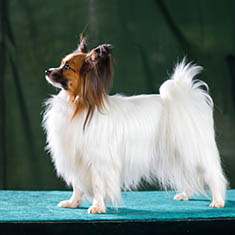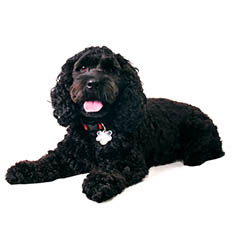Top Ten Dogs for Novice Owners
The good folks at VetStreet recently polled 218 veterinary professionals to find out which dog breeds they thought were best for new owners. Although it’s true that not every dog of a particular breed can be lumped together in all ways, certain breed characteristics will hold true for a majority of the dogs in a breed.

The nature vs. nurture debate is almost as old as the one about the chicken and the egg. It’s likely that both genetics and environment play a role in determining any dog’s temperament. Training and socialization make a big difference in the way any particular dog will turn out, but the historical strengths of the breed will also play a role.
A big part of the evaluation seems to rely on size, with at least five of the breeds being those where the dogs are less than 18” tall. The Poodle ranked highly, and could be either small or large, depending on the size variety you choose. The other four dogs are medium to large-sized, with no giants on the list.
The experts also included several “designer breeds” on the list – dogs that are the product of cross-breeding two purebreds. It’s unusual, but refreshing, for cross-bred dogs to be included on a list of this type. Keep in mind that cross bred dogs do not have the depth in their pedigree that purebreds do, so it’s hard to generalize about things like temperament and size. Depending on which two individual dogs are mated, and which genes end up being dominant, you can produce very different specimens of the same designer breed. And if you buy from a breeder who mates cross-breed to cross-breed, you have no idea what you are going to get. Responsible designer breeders mate foundation breed to foundation breed. The resultant mixed dog is never used for breeding.
Without further ado, here’s the list:
10. Papillon: Like most small dogs, the Papillon doesn’t realize he’s not very big. He is active and energetic, and will likely want to play with your kids and other dogs. If you’re an active person, this may be just the right fit for you. The small size makes this dog perfect for apartment living, but his high energy will require frequent walks or trips to the dog park.

9. Boston Terrier: Bostons are known to be little clowns and can spend hours entertaining you. They are small enough to fit into any living space, and will be happy as long as you spend some time each day with them. They like nothing better than to please you. Their short hair means there’s virtually no grooming required.
8. Bichon Frise: This fluffy little character was bred for no other reason than to be a companion for you and your family. They are very affectionate and enjoy cuddling. A quick daily walk and a buzz cut every 6 – 8 weeks will keep your Bichon healthy and looking good.
7. Labradoodle: The Labrador has been the most popular purebred in America for at least the past ten years, so it’s no surprise that a dog bred from the Lab would also be featured on a list like this one. The size of a Labradoodle depends on the size of the Poodle that was bred with the Lab. Although you won’t find a toy-sized Labradoodle, the dog created from a Lab and toy Poodle will be smaller than a dog created from a Lab and standard Poodle. No matter the size, Labradoodles are usually moderately active, playful, and smart.
6. Goldendoodle: Another cross-breed involving a Poodle, the Goldendoodle’s other half is a Golden Retriever. They often make wonderful family dogs, but they may or may not be hypoallergenic, depending on whether their dander and saliva genes are dominated by the Golden or by the Poodle. Goldendoodles are friendly and intelligent, and their activity level is generally moderate.
5. Cockapoo: Are you sensing a theme here? This dog is again a cross-breed resulting from the mix of a Poodle, this time with a Cocker Spaniel. This particular mix usually produces a fun and affectionate dog who doesn’t shed very much, but does require professional grooming.
4. Cavalier King Charles Spaniel: This spunky spaniel is a toy breed that is equally happy on your lap, out for a stroll, or playing with your kids. They are friendly with strangers and adaptable to nearly any lifestyle. Positive training methods work best with this slightly stubborn dog, and they are intelligent enough to pick up their lessons quite well.

3. Labrador Retriever: There’s a reason this dog tops the AKC’s annual list of most popular dogs in the United States. They are smart, relatively easy to train, loving, and athletic. Whether you’re looking for a hunting companion or a canine athlete, the Lab will easily fit into your plans. They are, however, VERY active during a long puppyhood. Patience is required to get to the good part.
2. Poodle: Available in three size varieties, the Poodle is beloved as a family pet. They are not quite as needy as some other breeds, which means you can get your daily chores accomplished without a shadow “helper”. If you keep your Poodle’s coat clipped short, you won’t have any trouble with grooming, but if you plan on a show Poodle coat, be prepared to spend a lot of time visiting a professional groomer. Poodles are one of the few breeds that is truly hypoallergenic and rarely sheds.
1. Golden Retriever: The quintessential family dog, the Golden Retriever is laid back enough to get along with absolutely anybody. Warning: this means they are equally welcoming to the neighborhood ax murderer as to your family members. Aside from his absolute lack of guard dog ability, the Golden has a great reputation as a loving and loyal family member. You will spend some time grooming your Golden unless you keep him clipped, but the dog is such a people-pleaser, you will likely enjoy any time you spend with him.
If you are a more experienced dog owner and looking for a challenge, be sure to check out our Top Ten Dogs for Experienced Owners.
Doggies Den: Latest Articles
 Homemade Thanksgiving Treats for Your Dog
Homemade Thanksgiving Treats for Your Dog
NUTRITION We all want to include our dogs in our holiday celebrations, but hopefully, you're aware that sharing table scraps with your dog isn't always the best idea.
 Keeping Your Dog Safe during the Summer Months
Keeping Your Dog Safe during the Summer Months
HEALTH Summer is coming on fast, so it’s time to plan how you will keep your dog safe and healthy through the lazy, carefree, warm days.
 Vaccination Time Again-Keeping Your Puppy Healthy
Vaccination Time Again-Keeping Your Puppy Healthy
DOG HEALTH So you have your new puppy picked out. There are quite a few shots, treatments and examinations that will keep the newest member of your family healthy.
 Canine Thanksgiving Feast
Canine Thanksgiving Feast
NUTRITION With the wide variety of food at Thanksgiving dinner, chances are you'll want to give your dog something special, too. If you're contemplating what to feed your dog for the holiday, here is a guide to a great Canine Thanksgiving Feast.
 Dog Walking Tips Every Owner Should Know
Dog Walking Tips Every Owner Should Know
DOG FUN Walking your dog is not only crucial to keeping him healthy and happy, it strengthens the bond between your canine friend and his caregiver. There are a lot of obstacles out there. Don’t forget these simple tips to keep your walk fun and safe in the outside world.
 The Benefits of Physiotherapy for your Dog
The Benefits of Physiotherapy for your Dog
HEALTH The same techniques that physiotherapists use to treat a variety of injuries and conditions in humans have been adapted to suit animals with great success. Family pets, show dogs, and working dogs can all benefit greatly from physiotherapy. Dogs whose activities involve a lot of agility are especially susceptible to the types of problems that physiotherapy can address.
 The Decision- Adding a Dog to Your Family
The Decision- Adding a Dog to Your Family
FIRST TIME OWNERSBringing a dog into your family is a decision where many people don’t realize it’s magnitude until after they have the dog. There are a number of things that you need to research before you decide to purchase a dog, and it starts right in your own home.
 Bringing Your Dog Into Your New Baby's Life
Bringing Your Dog Into Your New Baby's Life
HEALTH Many believe that a dog and a new baby cannot happily coexist, so therefore the dog has to go. This is not necessarily the case.  A new baby does not mean you have to abandon your dog.

Doggies Den:
Most Popular Articles

Dog Pregnancy Symptoms
HEALTHIf you suspect your dog might be pregnant, check out part one in this series on pregnant dogs, where we cover pregnant dog symptoms.

Dog Birth
HEALTHIn the third article of our dog pregnancy series, we look at the wonderful, but messy, process of bringing newborn puppies into the world.

Indoor Dog Potties
DOG PRODUCTSIt's been a long day at work. You were so busy, you didn't even take time to eat a sandwich, let alone run home to let your dog out. You're on your way home, knowing the poor dog is crossing his or her legs by now, when your car breaks down, delaying you even further. Can't somebody make this easier?

Your Dog’s Digestive System
PHYSIOLOGYEver wonder why your dog eats so fast? Or why he eats gross things? Or why he gets sick to his stomach? Or why his waste stinks so bad? Some of these things are normal, some are not.

Canine Respiratory System
BREATHINGThe basic function of your dog's respiratory system is to bring oxygen in to and remove carbon dioxide from the body. Knowing the symptoms of respiratory diseases can help you help your stay healthy.

Shelter Dog Adoption Tips for Success
ADOPTION Are you intimidated by the prospect of "rescuing" a dog from a shelter? One reason that you may be wary of adopting a dog from a shelter is not knowing how to choose. Adopting a dog from a shelter can be a rewarding process, if you're prepared to do a reasonable amount of research.

Canine Urinary Tract Infections
SYMPTOMS AND TREATMENTDoes your dog seem to be having trouble relieving his or her bladder? Learn how to recognize the signs of urinary tract infections and how to treat them before they spread.

What to do for Dog Diarrhea
SYMPTOMS AND REMEDIESIf you have dogs in your house for any length of time, you have likely experienced at least one bout of dog diarrhea. Beyond the pain in the tuckus involved in cleaning up the mess, you should know what causes diarrhea, and when it's important to see the vet.

What to do for a Dog Bite
DOG BEHAVIOR Getting bitten by a dog can be scary, and you may be tempted to run around in circles for a while, trying to figure out what to do. Here's our guide to help you manage the situation.

Top Ten Tips for Living with a Senior Dog
DOG HEALTH Bringing home a new puppy is so exciting, but it doesn’t take all that long for your exuberant puppy to grow into a senior dog who may have special needs. Here are the doggies.com top ten tips for taking care of your companion who has been with you through so much.
